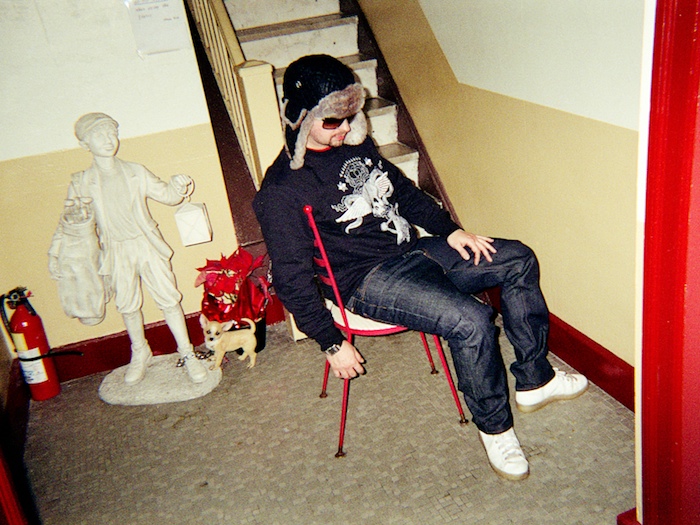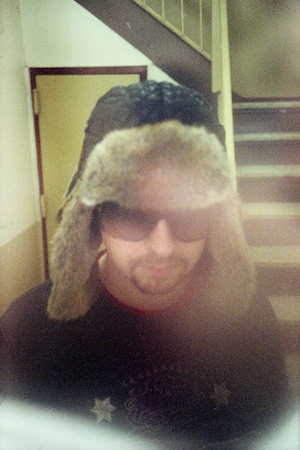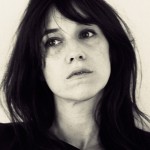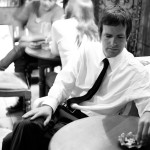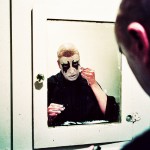Photos by Aaron Richter
Words by Andrew Parks
First it was a mask. Then a samurai helmet. And finally, after days of deliberation, a simple sunglasses-and-snowcap ensemble for Steve Goodman–the DJ, producer and Hyperdub founder best known as Kode9–to wear to his self-titled photo shoot. Simply put, Goodman prefers not to have his picture taken, but after stopping by our office for an interview, the genteel Scotsman relented on the condition of maintaining a sliver of anonymity in his image.
Call it finicky, but such controlling behavior is fitting for the man behind the post-apocalyptic dance tracks of Black Sun, a.k.a. Kode9’s second album alongside the Spaceape. Available next month through Hyperdub, it’s an otherworldly listen that unfolds like a paranoid film adaptation of Philip K. Dick, brimming with chest-caving bass lines, radioactive synths, and beats that riddle the pockmarked countryside like swiftly sprayed bullets.
It’s also his most fully realized musical vision yet…
“It’s hard to understand how we got into that headspace”
I wanted to start by asking you about the New York gig you did with Flying Lotus last year. It seemed like a great example of how many U.S. listeners aren’t as into underground dance music as we think they are.
People seemed to be into it, but they didn’t want to dance, really. It was a weird experience, actually, as it was packed in there and I didn’t really see much movement at all. I think people came to that gig expecting a performance and I’m not really into that. Not when I’m doing a DJ set, anyway.
How are you planning on performing your new record?
We have a live set. Like the album, it’s more upbeat [than the last Spaceape record, Memories of the Future]. We can do the downtempo thing blindfolded at this point. What we’re trying to do is crank the pressure up in a more dance context if we need to. The set needs to be adaptable.
Well I think people associate you mostly with more morose music.
Yeah, or they just think I’m a dubstep DJ and expect me to be playing nothing but that.
A lot of what you DJ is still fairly new to people in the States, too. Like many people here still haven’t heard of the UK funky scene.
As usual, there’s pockets of people who keep up to date with it all. It depends on the context, really. With that Flying Lotus tour, the best gigs for me were Detroit and Minneapolis.
Minneapolis seems a little random.
It may seem that way, but they were up for dancing, and Detroit was as well. Moodyman played the warmup set for that one. It was one of the most laid-back warmup sets I’ve ever seen. Just perfect. New York and San Francisco were similar in that they were sold-out, but people seemed to want to watch a performance.
Shifting back to your own music, how did you first cross paths with Spaceape?
Through his partner at the time, who’s his wife now. We ended up sharing a flat together in about 2001 and started messing around soon after that. [The 2004 single] “Sign of the Dub†was the first track he’d ever made.
He’d never done spoken word before, or anything like that?
No, but that’s what we started with–some spoken word. Just messing around, really. It was an experiment of how we could start making music together in as simple a way as possible.
Did it take him a while to find his footing as a performer then?
Yeah, he’s become a very dominating performer over the last three years. When we do a live DJ set now, he’ll be right in the middle of the crowd, stirring things up.
Does that freak people out?
It does. [Laughs]
How has his voice changed on this record?
It’s still manipulated a bit, but it’s closer to his natural voice. The changes don’t have to do with pitch so much as the sense that he’s transmitting from another place–like a radio transmission.
The record sounds like the end of the world, with him reporting from the front lines. Did you come up with the concept together?
The concept came after the music. All we knew was we didn’t want to make it as catatonic as the last one. That felt like sleepwalking, really.
That’s what’s cool about it, though.
I know, but we listen to it now, and we can’t figure out how we slowed our metabolism down that much. It’s hard to understand how we got into that headspace so easily. So yeah–we wanted this one to be more upbeat, more colorful, and more synth-oriented musically.
“It’s fiction in the end”
So you laid down all of the tracks before you touched the lyrics at all?
We experimented with elements of the music over the past three years in our live set. We’d make a melodic element, a sample, or a synth riff, on a month-by-month basis, always changing up the basslines and swapping the vocals between different tracks until it crystallizes and coheres. Which didn’t happen until the middle of last year.
Did the record start off sounding a little more catatonic and then evolve from there?
Yeah, it emerged out of these “Bass Fiction†live sets that we were doing, which had no drums in them at all. We wanted to make the tracks danceable without using any beats, whether that means using a rushed hi-hat or more dynamic basslines. And that took on a direction of its own. We just wanted it to have more energy.
When did the lyrical concept come together?
There’s a story that emerged out of what we were making. We elaborated on it in the artwork. The thing is set in a world of its own, where some kind of radioactive event has happened. We don’t know what it is, but it changed our sound and the content of Spaceape’s lyrics. A lot of them are about health, about the body undergoing mutations. So we were trying to figure out where that was coming from, and elaborate on a world around it–a radioactive event that’s changed the atmosphere. That’s why we have these different colored suns–because they’re refracted through this really toxic air. The population in this world is undergoing changes from this radioactivity. Part of it’s trying to deal with it by turning to monotheistic gods for salvation, and the other part is taking synthetic substances to enable them to survive in this environment.
While we haven’t faced a nuclear attack like that, some members of our society have a similar level of paranoia these days.
There’s certainly resonances with what’s going on in the world, but it’s fiction in the end. So while a song like “Bullet Against Bone†sounds like it may have come out of the student riots in London, that wasn’t intentional. The lyrics were written before that.
So it’s not a political statement in any way?
It could be for some people. We’re not against that, but that wasn’t the intention. The lyrics are fictional.
Does the Spaceape represent different characters in the record, or just one?
The album is from his point of view. He’s telling stories of people in this world. So for example, the song “Promises†is about how:well, it’ll be clearer with the graphic novel thing in the album, but it’s a bit like that [George Lucas] movie THX-1138, where sexual relations have become outlawed. Spaceape’s lyrics come from things that are going on and places you’d never expect. Everything’s a building block for something else rather than a simple reflection of reality.
“We wanted it to be more special than just some beats”
When did the story come together then?
Once when we finished the tracks. Things shift around all the way until the end. Only then can you reflect on what you’ve just produced; then you have to think about the artwork, and the world that’s been conjured up by the lyrics. We knew it was going to be a radioactive world [all along] because I suppose that’s how we feel the synths sound. It’s like being zapped.
You know, there’s this cereal in the UK called Ready Brek. It’s like porridge oats, and in the ‘70s, they used to have these adverts where there’d be this radioactive glow around you after you’ve eaten these oats and stepped out in the snow. We were kinda obsessed by this image–that certain people in this world have this glowing aura around them because of this experience. And certain people were hostile about that, and certain people went with it. The Other Men are the ones who are hostile to this mutation, whereas the other characters almost have an affinity for this mutation.
Is it supposed to be viewed as a threat?
For us, it’s not a threat, but it is for this monotheistic population. They seek salvation from the mutation by turning to god. The story ends with some people trying to escape to this Babylon-like world, and we just stay and bathe under the black sun. That’s the last line in the story.
Yeah, there’s like these dying embers in the end, and then it all fades to black.
It probably sounds dire to most people, but it’s not as dystopian an album as the first.
Would you rather people not view this one as such a dystopian narrative?
It’s just a pigeonhole we’re in. I can understand how it describes some of what we do, but I think we’d just like people to view this album based on what we’ve done [now] rather than what we’ve done before. That “Kryon†track is weird, but it ends on an up note in a sense.
Did you and Steven [Ellison, a.k.a. Flying Lotus] work on that in person at your studio?
We started it three or four years ago in my studio. I probably did about 20 different versions since then. Spaceape and I would finish our live sets with that synth riff at the end of “Kryon.†Kryon itself is meant as a New Age movement–our name for the section of the population in the story who’s reacting against the mutation and wants to retain their humanity. The final part of that track is the core of what I did with Flying Lotus. None of the beat versions worked, really.
So are those all improvised synth lines?
Yeah, we were fucking around for about four hours with one of my synths, then we cut it up and spliced it together to make this one riff that’s in the second, final part of the track. And I messed around until it did that initial riff justice. We wanted it to be more special than just some beats.
You’ve released music by Flying Lotus and his friend/collaborator Samiyam. What do you like about those two in particular?
I like a lot of their synth lines, basically. I’d never heard them done like that before–this feeling that’s almost like they’re breathing, like they are living, pulsing entities. That’s what I love about those guys in particular.
And you have artists on your label that were making similar music around the same time:
I suppose in the UK, the more synth-y stuff came after Skream did [the single] “Midnight Request Line.†Bringing melody into what was once a sonically gray scene, you know?
Are you surprised that Skream and his Magnetic Man group have essentially become pop stars in England?
They are pop stars, with all the sex, drugs, and rock ‘n’ roll. To be honest, I can’t think of anyone I’ve known from the beginning of dubstep who deserves it as much as them. Sometimes with a scene, people come out nowhere and get all the adulation. So what’s nice with Benga and Skream is that they were there at the beginning, and they’re getting the love they deserve. I mean, they’re such industrious guys. They make so much music, and production wise, it’s of a certain quality. So I’m really happy for them. I’m not as into that direction musically, but good luck to them.
Some of the earliest Hyperdub parties were hosted with Darren [Cunningham, a.k.a. Actress], who went on to co-found Werk Discs. What kind of stuff did you all DJ back then?
Darren was always coming more from a Detroit techno angle. He did a live set at the first Hyperdub event. Back in 2001, we did this sorta prophetic party called Hyperdub 130. I was playing UK garage/two-step, Darren was playing Detroit techno and electro, and the other guy, Gavin [Weale, also a Werk co-founder], was playing broken-beat. The only thing that held us together musically was keeping things around 130 BPM. Anyways, around 2001, we did this big event at the ICU in London, where we showed films and Darren did a live set. It was really amazing. I have it on Minidisc somewhere.
Amazing how?
You could tell he’s a really talented guy. Werk is a label I have a lot of respect for.
That’s why I’m curious about those early days–while you don’t release the same kind of music all the time, Hyperdub and Werk have a similar attitude.
Yeah, Darren’s not attached to any one scene.
The one time he played here a year ago was kinda amazing, but he also played whatever the hell he wanted, whether or not the crowd was into it.
He really doesn’t give a shit as a performer. He can be kinda hostile musically, and it can read as stubbornness or confidence.
How would you classify your relationship with audiences?
As a DJ, I have a bit of a fuck you attitude. I learned that from DJing for 20 years. My relationship to dubstep has forced me to have that attitude, too.
Your ultimate goal is to get people to dance, though.
Yeah, but in my way, not just playing the tracks people know. You want a good response, but you want a good response on your own terms. Like I have a lot of unreleased dubstep music that’d drive the crowds I play to absolutely mental, but I’m not really into the music.
Most people in the U.S. don’t understand UK garage, let alone funky, so what do you think’s a good entry point for this kind of music?
How long have you got? [Laughs] A lot of the music I’ve played exists in this diagonal between hip-hop and house–hardcore, jungle, UK garage, dubstep, grime, UK funky. I’ve been in phases where I can’t bear to hear anymore breakbeats, or 4/4 kicks, but looking back on it, it’s all about surfing the line between these two [extremes].
Tell me about the new book you’re working on. Is it just interviews with other producers?
It’s a sequel to the first one (Sonic Warfare), and all interview-based–some musicians, some scientists, some military [personnel], some people who work in advertising.
Have any of the interviews been especially revelatory?
Definitely Hank Shocklee. Obviously Public Enemy and the Bomb Squad had a strong militaristic public image, but it was in their musical methodology as well. It wasn’t just a PR thing. Talking to him about sound bombing and using music as a form of warfare was an important starting point. I touch on so many things in the first book, so the second one is an attempt to do something a little more accessible that fleshes some of those ideas out.
So this book doesn’t focus on theory as much?
I talk to some theorists. That inevitability comes up a bit.
Did you have a breakthrough moment in school that got you into viewing things differently–through a more analytical or theoretical lens?
I got interested in it as a teenager, when I was into finding out what happened in the ‘60s with psychedelics and the intersection between that kind of counterculture and what was happening with fiction–with the Beats, and their relationship to what was going on with European literature. So I just took those strands further, into existentialism and that world.
Did any writers in particular stand out to you?
Kafka. I also got into really surreal, psychedelic literature. None of it was through school. I studied philosophy at university, but I didn’t find any of it particularly interesting until I discovered some of the French philosophers.
Do you like someone like Zizek–someone who brings pop culture into the mix?
He’s entertaining. I admire anyone who can find a balance between accessible pop culture and theory. I tried to do that with my first book–expose people to some ideas without watering down the theoretical.
Do you still teach?
Mostly film sound–the relationship between sound and music and the moving image.
I’m surprised you haven’t done any sound design or film scores yet.
I just don’t have the time. I’m desperate to, though. What we did with the new record was essentially create a storyboard for a film. So at this point, we’re basically doing invisible cinema.
What have you been reading lately?
A lot of [J.G.] Ballard. What’s weird is I stumbled upon this short story of his from the ‘60s–The Day of Forever–and it’s set in a world that’s a lot like what we visualized with our artwork. There’s even this great line: “She felt it on her face like a black sun.†I was like, “Fuck.†It’s great when you have these coincidences, these parallel tracks between different things you’re interested in. Suddenly they all resonate together.
So now that this record’s finally done, what do you have on your plate next? Finishing the book?
The book will be the main focus, and related to it, I have an art installation in New York this April. It’s the third installment of a series I’ve already done in Berlin and Sheffield. There’s a visual element to that, and this whole sonic fictional world surrounding it.
You created music exclusively for it then?
Not music. More of an audio essay, or an abstract play documentary thing. The original idea was to do a quiet, low frequency installation, but it ended up being quite noisy.
And in terms of the label, are you going to keep as busy a release schedule as last year?
Yeah, we’ve got our album, a remix album from King Midas Sound, an album by our new signing Morgan Zarate, and an album by Cooly G.
Who’s on the King Midas Sound record?
Flying Lotus, Gang Gang Dance, Ras G, Hype Williams, Darkstar, Martyn, Mala–just people’s reinterpretations of that album.
And no Burial record?
Our situation with Burial is we’ll release something when we release it. I’m sick of talking about it to be honest, because it always spirals out of control with speculation. It’s better that I release the music when it’s ready. And since it’s not ready, I have nothing to talk about.
You must be excited that people want to hear the record that badly though?
Yeah, it’s wonderful, but there’s excitement and then there’s:we get like hostile E-mails saying, “How dare you not give us what we’re waiting for?â€
You should just randomly release it one day.
Maybe we will.
